Lesson 2 Native Americans & Settlers
Within Lesson 2 are a variety of activities and materials that can be used with students of various grade levels. All of these items are tied to the NET Nebraska Studies Timeline materials which are shown and linked throughout the lesson. Teachers are not intended to use all of the contents within this lesson but to pick which activities or materials they would prefer to use with their students. Most of the materials are shown within the lesson and/or have external links to the content or other content which may be helpful to the lesson's activities or materials.
You can also directly access all of this lesson at the NET Nebraska Studies website: http://nebraskastudies.org/
Created for NET by Michael Young, former History Department Chair, Omaha Burke High School
1850-1874 Native Americans and Settlers
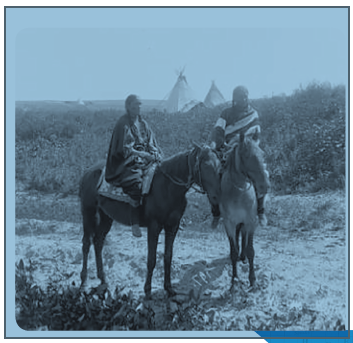
American Indians on Horseback
American Indians on Horseback
CONTENTS OF THIS LESSON
1. DISCUSSION - Native Crops Grade Levels 4 & 8
2. DRAWING - Earth Lodge Construction Grade Levels 4 & 8
3. DISCUSSION - Native American View Grade Levels 4 & 8
4. PHOTO ANALYSIS - Settler v. Native American Homes Grade Level 12
5. DISCUSSION - Tipis v. Earth Lodges Grade Level 12
6. LESSON PLAN - Our Perspective of the Homestead Act Grade Level 8
7. RESOURCES
8. Nebraska Department of Education Content Area Standards
1. Native Crops Grade Levels 4 & 8
Reading & Discussion
Have students read the Native Americans Meet the Challenges pages (shown below or use link) from the Nebraska Studies 1850-1874 timeline:
Then, discuss the following questions:
- What crops did early Native Americans plant that are similar to those grown by the settlers who moved in later?
- What crops are grown today in Nebraska?
- Why do farmers in Nebraska raise those crops?
- What are some differences in the way Pawnees farmed compared to farmers in Nebraska today?
- Were Native Americans in Nebraska subsistence farmers or commercial farmers?
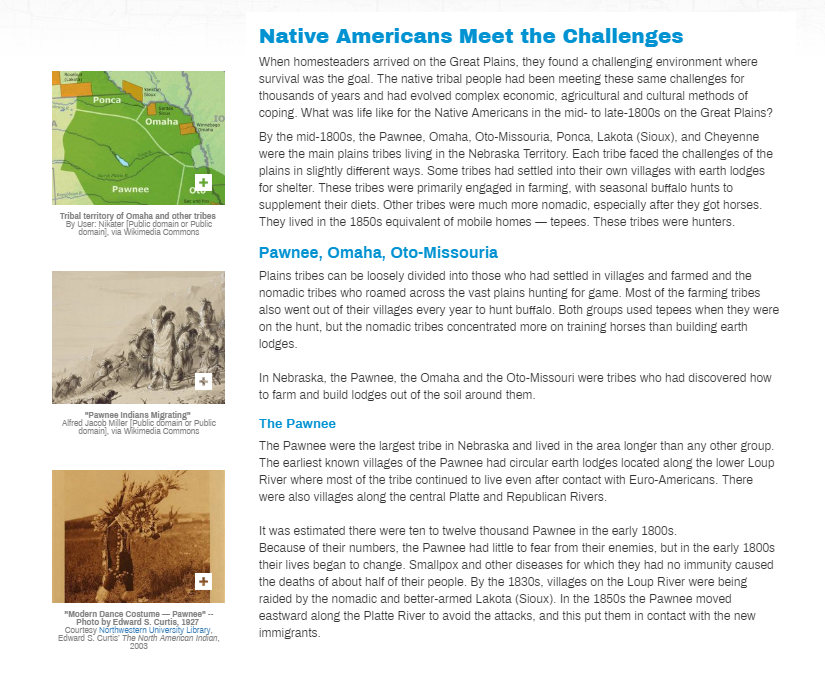
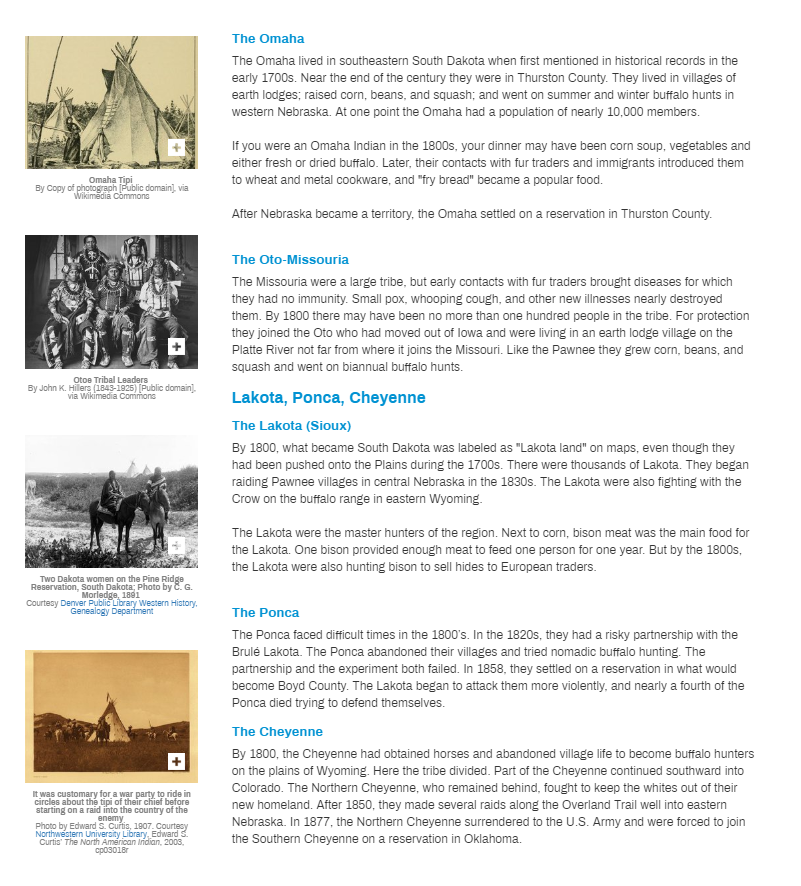
Page 2
Nebraska Department of Education Content Area Standards
Social Studies Standards: SS 4.3.1; SS 4.3.2; SS 4.3.5; SS 4.4.2; SS 4.4.3; SS 4.4.4; SS 4.4.5; SS 8.4.2(US); SS 8.4.3(US)
Language Arts Standards: LA 4.1.6 Comprehension; LA 4.4.1 Information Fluency; LA 8.1.6 Comprehension; LA 8.2.1 Writing Process
2 Earthlodge Construction
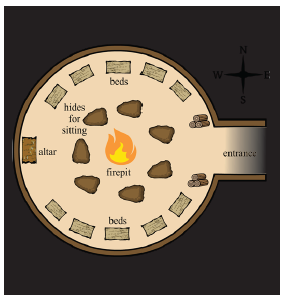
Earthlodge construction
Earthlodge construction
Activity - Drawing
Have students read the Architecture of Lodges page in the Nebraska Studies 1850-1874 timeline.
Then have students draw a series of pictures showing how a Native American earthlodge is built.
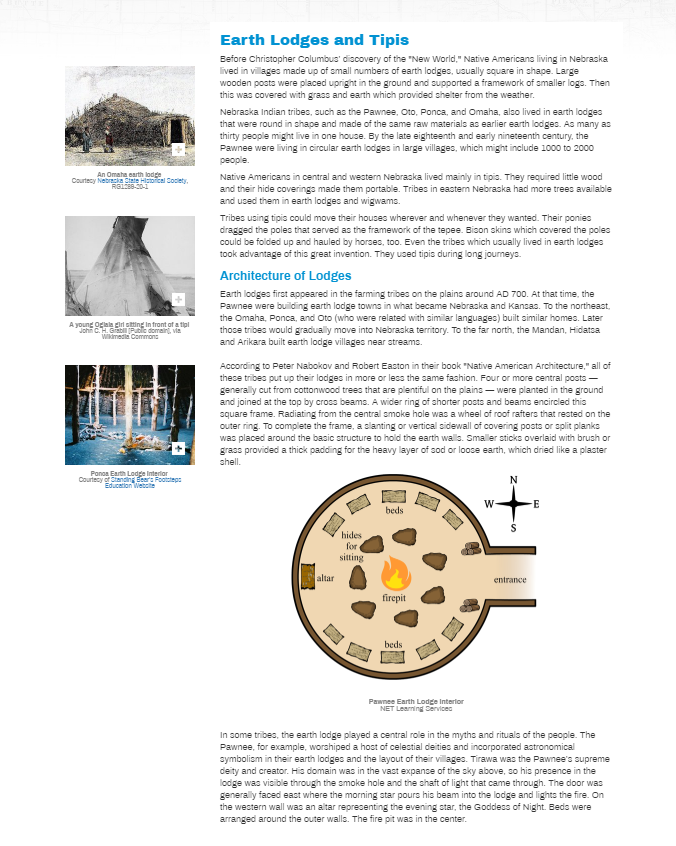
Earthlodge Reading
Nebraska Department of Education Content Area Standards
Social Studies Standards: SS 4.3.1; SS 4.3.2; SS 4.3.5; SS 4.3.6; SS 4.4.2; SS 4.4.3; SS 4.4.4; SS 4.4.5; SS 8.4.2(US); SS 8.4.3(US)
3 Native American View
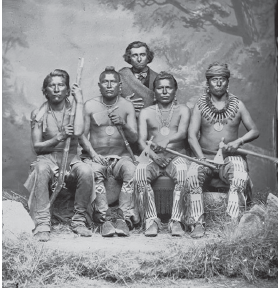
Native Americans & European Settlers
Activity - Discussion
Have students read the Conflict with European Settlers page in the Nebraska Studies 1850-1874 timeline. (below)
Then, have students discuss the following questions:
- How did Native Americans view the arrival of white Europeans?
- Why did the many of the Pawnee decide to help the U.S. Army?
- Why did the Lakota dislike the people traveling through Nebraska
- on their way to Oregon and California?
- What were the two main goals of the Fort Laramie Treaty of 1851?
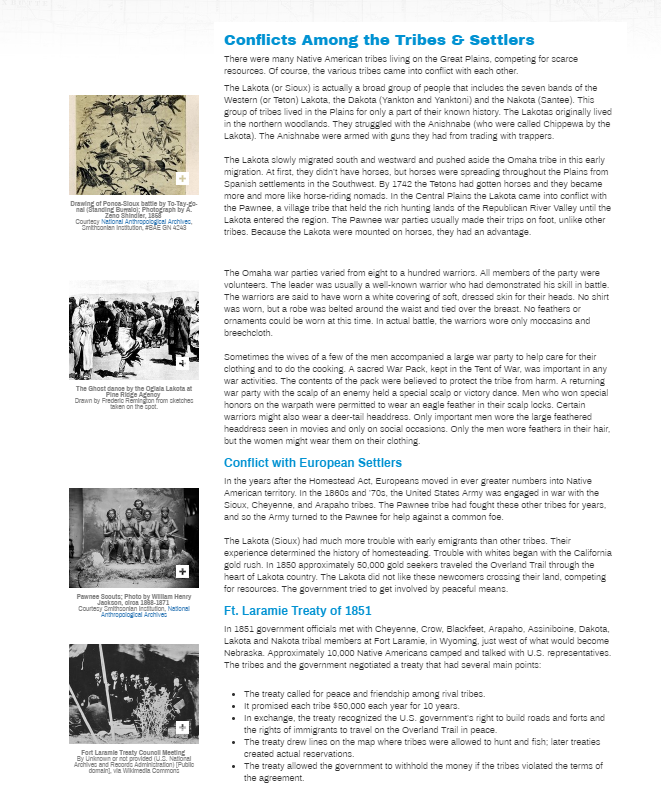
Conflict Page 1
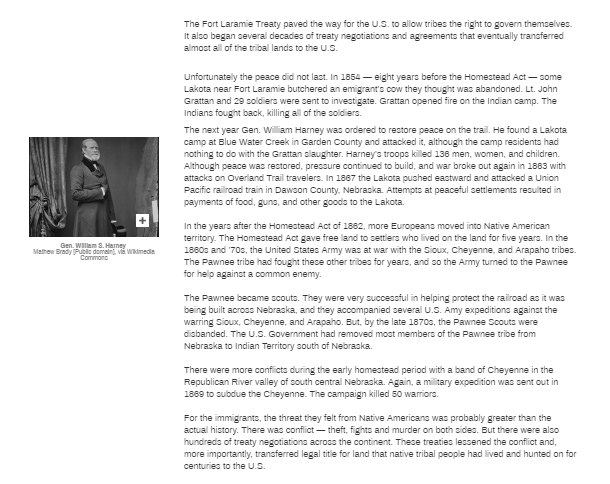
Conflict Page2
Nebraska Department of Education Content Area Standards
Social Studies Standards: SS 4.3.1; SS 4.3.2; SS 4.3.4; SS 4.3.5; SS 4.3.6; SS 4.4.2; SS 4.4.3; SS 4.4.4; SS 4.4.5; SS 8.4.2(US); SS 8.4.3(US)
Language Arts Standards: LA 4.1.6 Comprehension; LA 4.4.1 Information Fluency; LA 8.1.6 Comprehension; LA 8.2.1 Writing Process
4 Settler v. Native American Homes
Activity - Photo Analysis Grade Level 12
Have students read the following pages in the Nebraska Studies 1850-1874 timeline - Earth Lodges and Tipis and Architecture of Lodges.
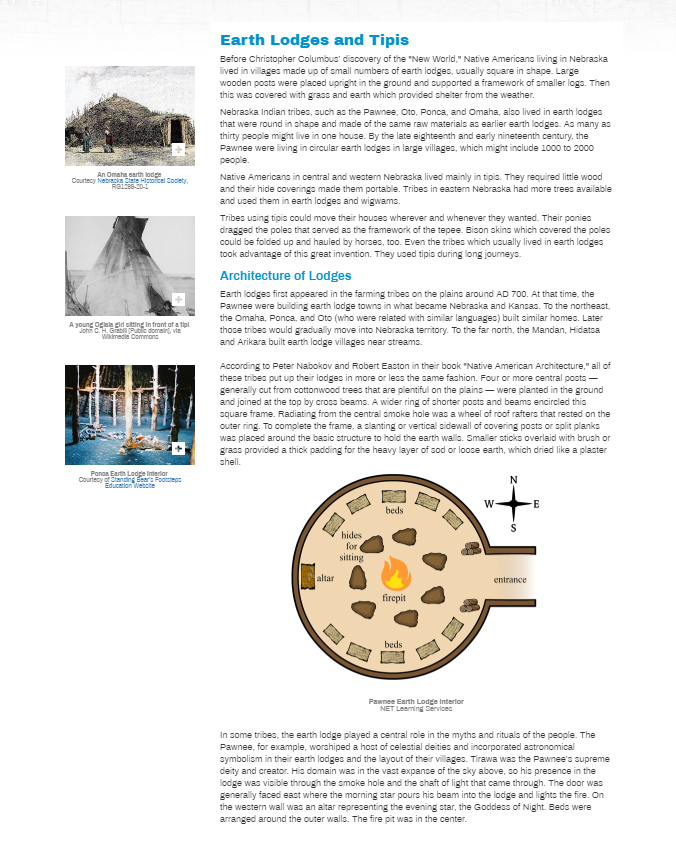
Earthlodges
Suggest that students use the links below to find and analyze photographs of different dwellings, houses, or tepees. Students could also complete a National Archives Photograph Analysis Worksheet in the Resources section at the end of this document for the analysis of images they find. After reading the selections, students should write short descriptions of each of the types of Native American Homes and then write an analysis on each type of home discussing the advantages and disadvantages of each. Students could also be asked to write about how each type of dwelling reflected the needs and building materials available for different geographic areas. Then have students compare and contrast European settlers’ homes with Native American homes during the mid-to late-1800s. The links below have more information on various types of housing that students can also use for this assignment.
https://www.nps.gov/knri/learn/historyculture/earthlodge.htm (Mandan Earthlodge)
https://www.warpaths2peacepipes.com/native-american-houses/earth-lodge.htm (Earthlodges)
http://www.hhhistory.com/2016/04/the-iroquois-longhouse.html (Iroquois Longhouse)
https://www.britannica.com/topic/wickiup (Wickiup)
http://plainshumanities.unl.edu/encyclopedia/doc/egp.arc.048 (Tipi)
Nebraska Department of Education Content Area Standards
Social Studies Standards: SS 12.1.1; SS 12.3.1; SS 12.3.4; SS 12.4.1(US); SS 12.4.5(US); SS 12.4.5(WLD)
Language Arts Standards: LA 12.1.6 Comprehension; LA 12.2.1 Writing Process; LA 12.2.2 Writing Modes
5. Tipis v. Earthlodges
Activity - Discussion Grade Level 12
Have students read the Earth Lodges and Tipis page in the Nebraska Studies 1850-1874 timeline. See above in 4. Settlers av. Native Amercian Homes for the reading.
Then have students compare and contrast the Native American tepee to the earthlodge. Explain how the construction of each structure was influenced by geography. After reading the selections within the links below, students should write short descriptions of each of the types of Native American Homes and then write an analysis on each type of home discussing the advantages and disadvantages of each. Students could also be asked to write about how each type of dwelling reflected the needs and building materials available for different geographic areas.
https://www.nps.gov/knri/learn/historyculture/earthlodge.htm (Mandan Earthlodge)
https://www.warpaths2peacepipes.com/native-american-houses/earth-lodge.htm (Earthlodges)
http://www.hhhistory.com/2016/04/the-iroquois-longhouse.html (Iroquois Longhouse)
https://www.britannica.com/topic/wickiup (Wickiup)
http://plainshumanities.unl.edu/encyclopedia/doc/egp.arc.048 (Tipi)
Nebraska Department of Education Content Area Standards
Social Studies Standards: SS 12.1.1; SS 12.3.1; SS 12.3.4; SS 12.4.1(US); SS 12.4.5(US); SS 12.4.5(WLD)
Language Arts Standards: LA 12.1.6 Comprehension; LA 12.2.1 Writing Process; LA 12.2.2 Writing Modes
LESSON PLAN - Our Perspective of the Homestead Act Grade Level 8
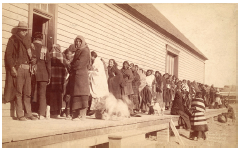
Native Americans wait in line for assistance
Lesson Objective -
Students will analyze the Native American’s point of view of the Homestead Act.
The Task -
Have students identify a Native American group (from the latter part of the 19th century) who lived in the area of Nebraska where they currently reside. Have them write a letter to the editor of the local newspaper discussing a Native American’s point of view of the Homestead Act.
Internet Resources
Nebraska Studies 1850-1874 website, Native Americans & Settlers section - http://nebraskastudies.org/1850-1874/native-american-settlers/
100 Milestone Documents, National Archives. - http://www.ourdocuments.gov/content.php?flash=true&page=milestone
PBS. New Perspectives of the West. - http://www.pbs.org/weta/thewest/program/
PBS. The West. The Nez Perce and the Dawes Act. -http://www.pbs.org/weta/thewest/lesson_plans/lesson03.htm
Prairie Settlement. Nebraska Photographs and Letters. [Butcher photographs and Oblinger letters] Library of Congress. American Memory Collection. -
http://memory.loc.gov/ammem/award98/nbhihtml/pshome.html
Teaching with Documents Lesson Plan: Maps of Indian Territory, the Dawes Act, and Will Rogers’ Enrollment Case File. National Archives. Digital Classroom. - http://www.archives.gov/education/lessons/fed-indian-policy/
Nebraska Dept. of Education Academic Standards. - https://www.education.ne.gov/contentareastandards/
Nebraska Dept. of Education State Social Studies/History Standards. -https://tinyurl.com/ycuxo8sh
Nebraska State Historical Society. - http://nebraskahistory.org/oversite/research.htm
Nebraska State Historical Society: Nebraska History magazine - https://history.nebraska.gov/publications/nebraska-history-magazine
Nebraska State Historical Society: Nebraska Trailblazer - http://www.nebraskahistory.org/museum/teachers/material/trailist.htm
Rubrics: General Rubric - http://www.socialstudieshelp.com/rubric.htm
School Improvement in Maryland. Instruction. Social Studies Rubric. - http://www.mdk12.org/instruction/curriculum/hsa/critical_thinking/soc_stds_rubric.html
The American Memory Collection. All Collections. - http://memory.loc.gov/ammem/amtitle.html
The American Memory Collection. Library of Congress. -http://memory.loc.gov/ammem/ammemhome.html
The Library of Congress Learning Page: The Historians’ Sources: Analysis of Primary Sources. “Questions for Analyzing Primary Sources.” -http://memory.loc.gov/ammem/ndlpedu/lessons/psources/analyze.html
The Process
1. On a map, have students indicate the location of Native Americans living in Nebraska in the latter part of the 19th century. Have them highlight the group that lived in the region in which they currently reside. More advanced students may wish to use the National Archives Map Analysis Worksheet in the Resources section at the end of this document.
2. Have students read the Native Americans & Settlers section of the 1850-1874 timeline on Nebraska Studies: http://nebraskastudies.org/1850-1874/native-american-settlers/ Read and discuss the effects of the Homestead Act on Native Americans and settlers.
3. Have students compare and contrast the effects of the Homestead Act on the lives of the Native Americans and the settlers. Have students chart this information on the chalkboard.
4. Ask students to accumulate information to support their assessment of how Native Americans viewed the Homestead Act. Direct students to write an editorial from the perspective of a Native American concerning his/her view of the Homestead Act. Tell them to support their positions with factual information.
Learning Advice
1. Review the Nebraska State Historical website at http://www.nebraskahistory.org and familiarize students with the Nebraska History magazine located at: https://history.nebraska.gov/publications/nebraska-history-magazine Teachers/students can order copies of the magazine from the NSHS or check with their local library to see if they have copies.
2. Review the contents of the Nebraska Department of Education Social Science Resource Home Page and review the links with students. https://www.education.ne.gov/socialstudies/
3. Review the format for an editorial and then model how to write one.
4. Review the chart (Step 3 in The Process) listing the similarities and differences between the homesteaders and the Native Americans with the students. The chart will provide students with a visual image they can refer to when writing their editorials.
Conclusion
Student will become aware and be able to explain the ramifications of the Homestead Act for the Native Americans and the settlers.
Assessment
Students may be graded on the map exercise, oral discussion, and written editorial. See a sample rubric in the Resources section at the end of this document. Teachers may wish to develop their own rubric to meet their individual needs.
Rubrics: General Rubric -http://www.socialstudieshelp.com/rubric.htm
RESOURCES - 1850-1874 Native Americans and Settlers
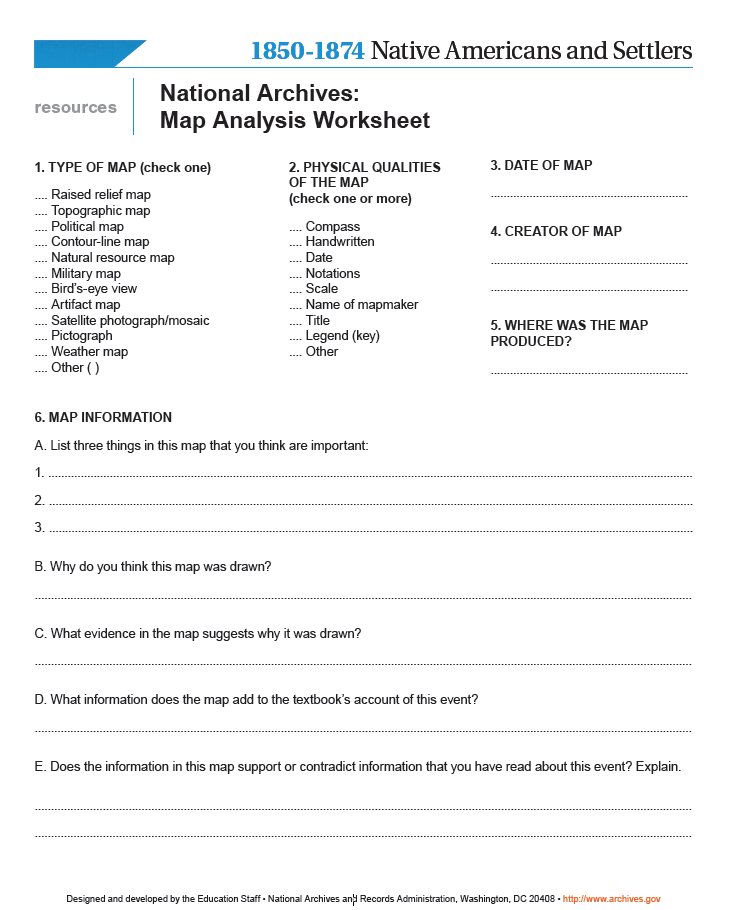
Map Analyisis Worksheet
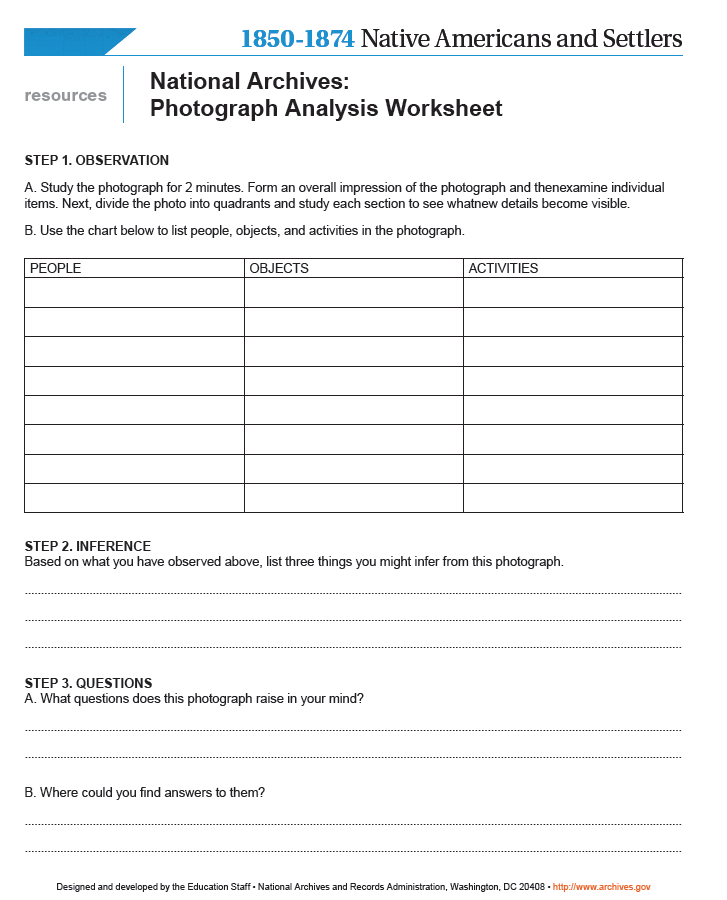
Photgraphic Analysis Worksheet
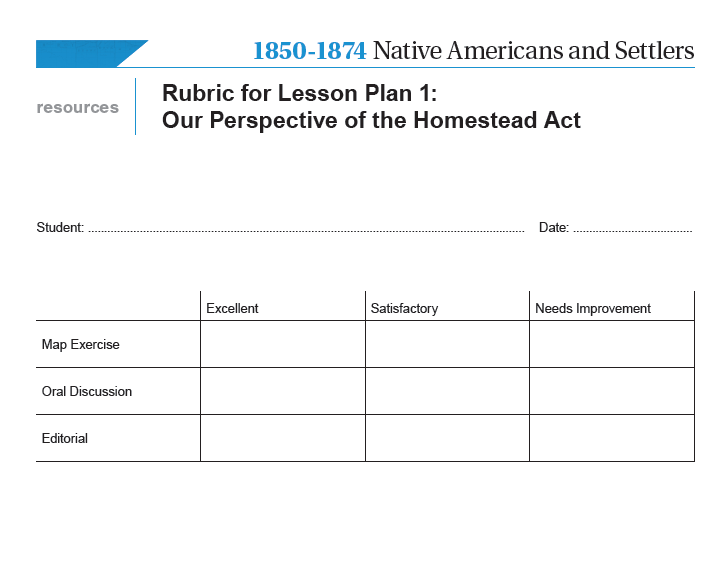
Lesson 1 Rubric
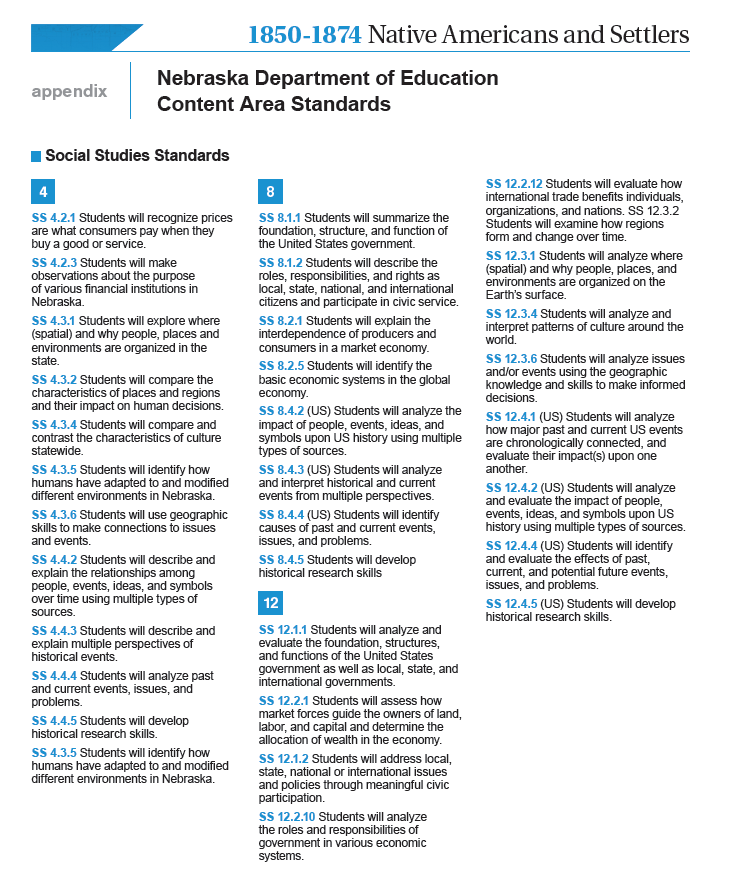
Nebraska Social Studies Standards Used
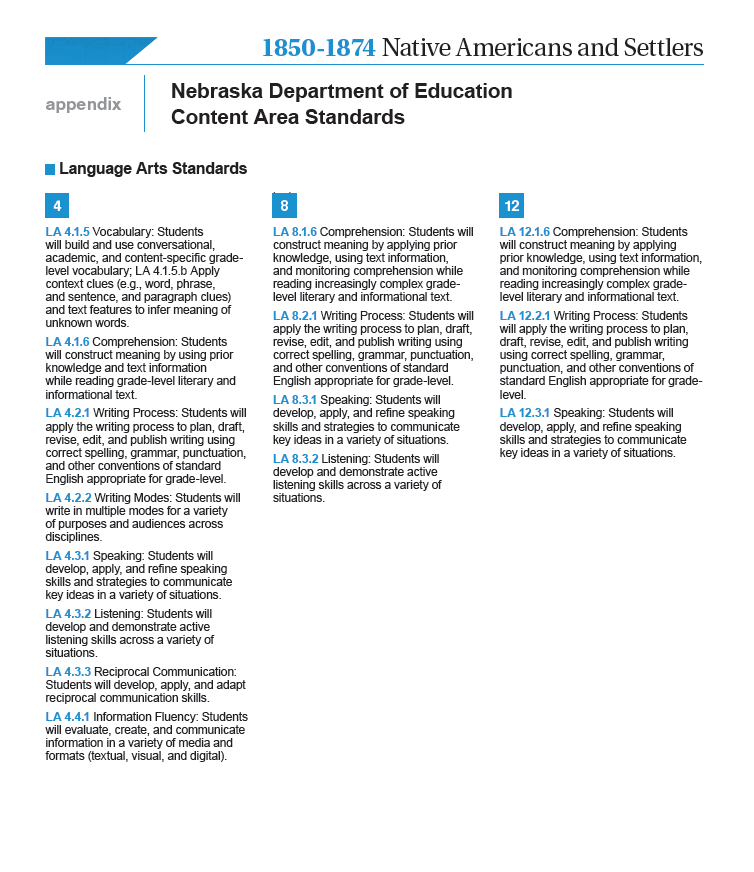
Nebraska Language Arts Standards used

Logo
